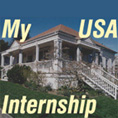 |
Californian
Ways...
...an internship report |
 |
 |
Californian
Ways...
...an internship report |
 |
1.1 Introduction
Only a couple of projects away from starting my graduation project I decided to first do an internship in a foreign country. Gaining working experience is a relevant aspect of getting prepared for the future career. There are additional benefits of gaining this experience in a foreign country, such as managing to work in a foreign language and dealing with a different culture and different building tradition.
In July 1999, I contacted fifteen architects from different places across the North American continent through the Internet, sending them an application letter in form of an e-mail with a resume attached to it [Appendix 1]. After receiving two refusals from large companies, a female architect and sole-practitioner by the name of Ms. Katherine Austin replied to my application with great interest. After a couple of months of correspondence, we agreed to a three-month internship at her architectural office in Sebastopol, Northern California.
Working with a sole practitioner appealed to me very much because of the one-on-one relationship I get to have with my employer and tutor. But more importantly I got the opportunity to closely behold every aspect of different functions and tasks my employer performs by being an architect and by running a business at the same time.
Getting to know Ms. Austin, and finding out that we have a lot in common, has resulted into a very casual and trustworthy relationship. This made the gained experience much richer than expected. The fact that there was a certain freedom of being open and honest and very informal with each other made it much easier for both of us to come forward with any questions or requests any time.
1.2 Objectives
Since I was still a student, I aimed to learn as much as possible, which made it difficult for me to point out one concrete goal for this internship. I summarize some of the most important objectives:
· to establish my weaknesses
and capabilities as an architect;
· to learn additional
aspects that an architect has to deal with in order to run a business,
such as management, juridical aspects, contacts with customers, the economics,
different materials or techniques and so on;
· to gain more insight
in relations between different parties included in the design-process:
architect, client, government (approving and checking if everything is
according to the building code), civil engineer, city planner, structural
engineer and others;
· to analyze the relation
between native and foreign (U.S.) traditions in architecture;
· to get to know the
personal style of the architect and her architecture in relation to the
local culture.
1.3 The assignments
Being a sole practitioner, Ms. Austin got very busy having twenty projects going on at the same time and was in great need of assistance. In this section I discuss the nature of assisting activities that were assigned to me during this internship.
Although AutoCAD is one of
the most used applications around the world, Ms. Austin uses DataCAD. American
architects in the Eastern states mostly use DataCAD and that makes it difficult
for the very few users of DataCAD in California to get in touch with each
other and share the knowledge of the program. Ms. Austin wanted to learn
this software and needed a person who could tutor her. She therefore gave
me the assignment of mastering DataCAD.
Ms. Austin also planned to
expand her house, but did not have time herself to draw the working drawings.
At the time of my arrival, Ms. Austin had already worked on the plans for
the expansion of her private home and she had made sketches of the design.
My main task was to use DataCAD to make the architectural (working) drawings
for the expansion of her house. Further on in this report I will refer
to this assignment as the Austin & Neely Project.
Since there was only one available computer I often resorted to helping Ms. Austin with other things at times that she had to use the computer. Some of these small chores were:
· copying documents
and drawings;
· bringing business
mail to the Post Office;
· getting blueprints
of drawings at the blueprintshop;
· stapling sets of
plans and folding sheets of drawings;
· organizing the flatfile
cabinet;
· helping move and
fit out the office in the third week;
· answering the phone
and writing down the messages.
With time I got better acquainted to the course of business and the number of activities I could assist Ms. Austin with increased. Soon I was asked to do some hand drawings for Ms. Austin and I also designed two plans. In section C of this internship report I elaborate on additional assignments regarding other projects then the Austin & Neely Project.
1.4 Weekly Justification of Activities
During my internship I have documented all my activities in a journal. This journal enabled me to provide the overview of the weekly progress in the following table.
Note that there was no pre-defined work schedule for each workday. Ms. Austin came and left the office as suited her, and assured me that my working times were not fixed either. I usually started working at 9 a.m. and worked on until 5:30 p.m.
Additional to the activities documented, I have been offered to attend any meetings regarding the on going projects. Ms. Austin and I also visited her projects, some that were under construction and some that were already built. The following list gives a short overview of these meetings and visits. Any complementing or documenting material is provided in the Appendix 2.
15th of March: - Ms. Austin and I visited the Greenway Gardens Project in Santa Rosa and the Woodstone Village Project in Sebastopol. The projects were under construction.
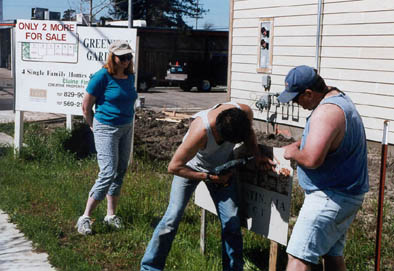

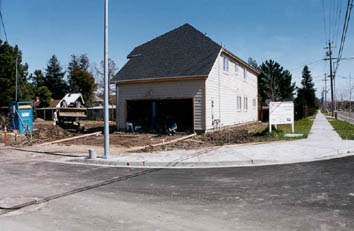
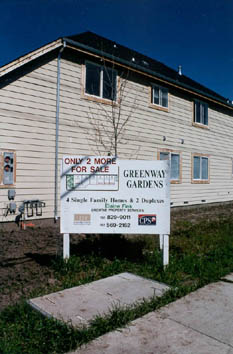
16th of March: - Neighborhood meeting for the Maple Village Project. Before submitting the drawings to the Planning Commission of the City, the neighbors who live near the planned site get together with the project-manager, city planner, civil engineer and the architect to talk about what is going to be built on the site.
23rd of March: - An AIA meeting on design with the architects from the area. The main topic of this discussion meeting was “The IDEA”.
26th of March: - Ms. Austin and I visited a number of her projects in Petaluma, Santa Rosa, and Healdsburg.
30th of March: - A meeting with the client and the project manager at Burbank Housing Development Corporation and Burbank Housing Management Corporation considering the Timothy Road Project.
10th of April: - A meeting with the client, David Poulsen, and the civil engineer, Charlie Traboulsi in Ms. Austin’s office considering the Lands of Victoria project. I co-designed two of the houses for this project [see Table of Activities]. 9th of May: - A neighborhood meeting for the Timothy Road Project in the City Hall of Santa Rosa.
31st of May: - A neighborhood meeting for the Maple Village Project. We had already had one in the beginning of my internship, now they have gathered again to review it as some changes have been made and the landscape design was finished too.
7th of June: - A breakfast meeting of the Sonoma County Alliance in Santa Rosa. Sonoma County Alliance is the association of business people in the county. The topic of this meeting was the issue of investing in affordable/ workforce housing in Sonoma County.

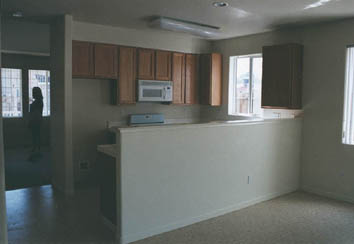

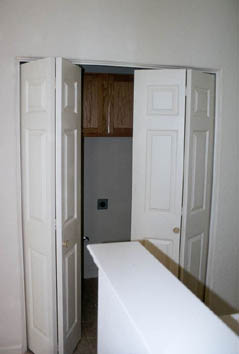
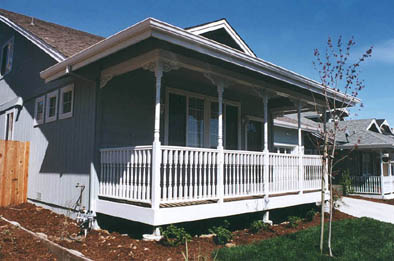
The Woodstone Village
Ms. Austin is specialized in residential projects that will provide the higher density, but add quality to the location by designing attractive site plans and preventing degradation to unattractive apartment flats. She is well known among the builders in the county for designing friendly neighborhoods with attractive extrovert homes that give out the feeling of social safety and privacy of home. She mostly achieves the higher density by designing attached rather than detached housing and/or by using subdivisions such as duplexes, triplexes and sometimes fourplexes, meaning combining two, three or four family-units in one house. I further elaborate on Ms. Austin’s way of work in chapter 3.
Being a member of the city council in the City of Sebastopol, Ms. Austin endeavors to educate the community about the importance of stimulating affordable housing in the city. Her social activities also help her to gain acquaintance with potential clients, which can be of support to her business and her efforts regarding affordable/ workforce housing.
Besides working with private
builders and developers, Ms. Austin also works with non-profit housing
corporations. These corporations try to provide affordable housing and
high density while maintaining or improving the quality of the site and
the city.
A project starts
with Ms. Austin making the designs and after the client is pleased with
the design a long process of submittal and getting approvals from the City
Planning Commission starts. During this process, which takes the most time
of the project, Ms. Austin is particularly communicating with different
parties. The draftsmen are making working drawings and adapting them according
to any changes. The consulting with the structural engineer and the landscape
designer as well as feedback to the client and the civil engineer take
place during this process. At the time of my internship, many projects
were going on and the designs for these projects had already been made.
Close to the end of my internship, Ms. Kathy got four new projects and
has made a site plan design for one of the projects. Besides for this project,
the only designwork that has been done were changes to the existing designs
when required by the client, the neighbors, the structural engineer or
the city.
Communicating with different parties takes the most of the time from the start to the completion of the project. Therefore a typical working day of Ms. Austin mostly rather includes different meetings and phone calls than designing. This may be one of the important aspects to consider when making the choice of being a sole-practitioner or running ones own office.
As mentioned before, Ms. Austin is planning on slightly changing the course of the business. She hopes to learn DataCAD in order to be able to create the working drawings herself. This would save her the time and the money she spends on hiring draftsmen and the inconvenience of continuous back and forth to communicate about the drawings and change them. On the other hand, this would mean that she would spend more time drafting and that she would have to decrease the number of the projects she can take at the same time.
Ms. Austin deals with a big
variety of activities to get done every day. Being the second person in
the office to assist with a number of those activities, I am inclined to
say that in the first place my position was one of a personal assistant.
However, having the important
assignment of creating the working drawings for the Austin & Neely
Project, my position included being the draftsman of the office.
There are many different aspects of this internship that enriched my knowledge and experience. Therefore the next paragraphs may seem somewhat incoherent to each other. Nevertheless I needed to mention every one of the described aspects in order to clarify the important lessons that this internship brought me.
3.1 The Main Assignment
In this section I elaborate on the main assignment of this internship: drafting working drawings for the Austin & Neely Project. A lot of preconditions had to be coped with before this assignment could take its final form. The following paragraphs describe a number of these preconditions.
The most important requirement
to be able to start drafting was the acquaintance with the software that
I had to use - DataCAD. Therefore, the first couple of weeks I was occupied
with working through the tutorial of the program.
Along with getting acquainted
with the program, I had to get used to the American way of dimensioning
and scaling, using English system of units. See tables 1and 2 for a description
of this system.
(Charts under construction)
The working drawings must meet a certain format rules, especially with residential projects. This means that every project is described in a set of blueprints in size 2 feet by 3 feet - to compare with European size A1 - which contains a set of architectural drawings and a set of structural drawings. A standard set of drawings is organized as follows:
1 Title sheet is the first sheet and contains data such as declaration of compliance to the law, nomination of the included parties, general notes to the contractor, the contents of the set, and often a site plan. The title sheet is keyed sheet T1.
2 Sheet A1 is the second sheet of the set and the first architectural sheet. It mostly contains floor plan(s).
3 The next sheet would be A2 and would contain elevations and a roof plan.
4 A3: an electrical and mechanical plan.
5 A4: sections.
6 A5: details.
However the set of drawings for the Austin & Neely Project included some other drawings too, because this was an expansion and not a project for a new house. The set thus included two site plans, the one with the existing house and the existing driveway that had to be demolished and one with the new situation. Then there was a demolition plan, which included the information about what part of the existing house had to be demolished and which parts had to be saved and reused. It also showed in which order the different phases of the expansion had to take place.
The DataCAD software is a very user-friendly program. It took me a month to get acquainted with it, after having to cope with a lot of problems and searching for solutions in books and on the Internet. I got very skilled in changing the drawings very quickly. The drawings were evolving simultaneously during the process, though they were not started at the same time. They went through continuous corrections and additions, marked up by Ms. Austin every time we printed the last version of the drawing on a small format. The adaptations to the drawings thus took place according to Ms. Austin’s corrections. The documentation of this process can be seen in the Appendix 3. The drawings depicted in the appendix are not to scale!
During this long process of
developing drawings, I learned a lot. Beside the aforementioned system
of dimensioning, I learned a lot about the Californian construction and
the Californian Code of building. Dealing with a slope on the site, dealing
with the regulations concerning minimal dimensions for the shear walls
or minimal distances from the house to the property line – [?] -, calculation
of the needed ventilation and the size of the attic-vents are few examples
of knowledge I gained along the way.
After twelve weeks of work,
the final set of drawings was ready to get submitted to the structural
engineer and the builder. That does not mean that no more adaptations needed
to be made. The drawings go through a process of approving by different
parties before the construction work can get started. Any required changes
and revisions must be done.
The final set included:
1 Sheet T1
It contained two site plans,
the list of the participating parties, compliance to the Title 24 of the
Californian Building Code, general notes, and the list of the contents
of the set.
2 Sheet A1
The floor plan of the house
as it is going to be after the expansion, with all the notes and dimensions.
Scale: ¼” = 1’-0”.
3 Sheet A2
This sheet contained all four
elevations, the vertical dimensions and the needed notes. Scale:
¼” = 1’-0”.
4 Sheet A3
The sheet presented the demolition
plan of the house, emphasizing on the existing floor plan, pointing out
the elements to be demolished or reused, and the phases of the expansion.
The roof plan was also presented on this sheet. The demolition plan scaled
¼”= 1’-0”. The roof plan scaled 1/8”= 1’ -0”.
5 Sheet A4
The electrical and mechanical
plan to scale ¼” = 1’-0”.
6 Sheet A5
This sheet shows the three
vertical sections of the house with notes and reference to the details.
The scale is ¼” = 1’-0”.
7 Sheet A6
This sheet contains seven
details referred to on the sections. The scale differs from 1”=1’-0” to
½” = 1’-0”.
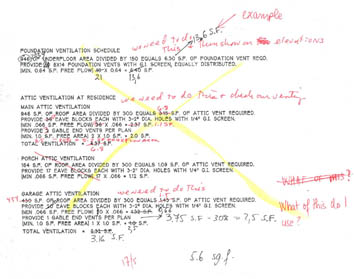
Ventilation calculations
3.2 My Designwork
In this paragraph I deviate from the main assignment to elaborate on designing that I was asked to do on the Lands of Victoria Project with the client being David Poulsen, a property developer. The project included four different types of residence on one site. Ms. Austin had designed the siteplan, and two types of houses, differing in square footage. She had specified another two types in approximate square footage according to the possibilities of her design of the site. My task was to design the floor plans to the specified outlines of the two houses and their front elevations.
This task was a difficult one on account of following reasons. The concept was already there, the context was interpreted and even the outline of the walls was specified. The amount of freedom that a designer usually gets for personal creativity was now limited. The first two houses for the same project were already designed and this was another limitation as one can hardly design something totally different on the same site, for the aesthetics, but also for the economics. Another reason is the different way of building that influences the way a house can be designed. There are standardized ways of building that the contractors practice and deviating from this practice would risen the costs.
Not being used to these limitations, I started with laying a puzzle of elements on the floor plan. I traced some rooms from the existing floor plans and tried to fit them in the new plans, adapting them a little. One of the reasons that I literally traced the rooms was the fact that I was not able to think in American units of scaling and dimensioning yet. The traced rooms were sized properly, and I did not have to recalculate every dimension from meters to feet to find out the good size. This made it easy for me to come up with the floor plan very fast. The next step was thus to revise the design and see whether the organization of the spaces could be improved. It was only after a small session with Ms. Austin though that I realized there were much more possibilities to fitting out the floor plan than I originally thought. The reason for this is the combination of limitations that I felt upon me and the lack of experience one needs to be able to deal with this kind of problems. This particular assignment meant a big lesson for me, and I now know how to cope with different limitations that building practice can bring. (pictures of my designwork still under construction)
In this section I hope to have given a short description and documentation of the design-assignment that I was asked to do for Ms. Austin. The handdrawings that I was asked to do for Ms. Austin are not described or documented in this internship report. These assignments were only additional and not such a challenge compared to the more serious tasks.
An interesting aspect of this internship is the opportunity to see which phases a project goes through from the first idea to the construction. The Appendix 4 shows a list of the projects that were going on during my internship and the stages they were in the first weeks and at the end of the internship.
A project begins with the contract that is set up by the architect, in this case Ms. Austin, and that is agreed to by the client signing the contract. The Appendix 4 also shows an example of the contract. In the contract the architect refers to the most important stages of the design process, the fees for every stage, the specification of the relations between the parties and their duties.
The following shows a list of all the stages that a project can possibly go through. When a phase is printed italic, then the phase applies to certain kinds of projects only.
1 Connecting with a (potential)
client;
2 Visiting the site and receiving
the documentation about the site and the bill of requirements, necessary
for designing the site plan;
3 Setting up a contract and
signing it (When it is sure that Ms. Austin is the only architect contacted
to do the project, contract may be ready and signed before a site plan
is designed.);
4 Revisions on the site plan
and the bill of requirements;
5 Designing the houses for
the project, including the floor plans and the front elevations only;
6 Submitting the
Master Plan to the Design Review of the city;
7 Hiring a draftsman to start
with the working drawings;
8 Continuous communications
between the client, the civil engineer, the architect and the draftsman
about the changes to the plans;
9 Approving of the plans by
the Design Review ;
10 A neighborhood meeting
to present the plan to the neighbors of the site;
11 Submittal of the Master
Plan to the Planning Commission;
12 Continuous communications
between the client, the civil engineer, the architect and the draftsman
about the changes to the plans;
13 Presenting the Master Plan
to the Planning Commission (Neighbors are welcome.);
14 Approving of the plans
by the Planning Commission of the city;
15 Depending on which intervention
is being done on the site, the architect and the civil engineer sometimes
have to set up a Development Plan, which also has to get approved by the
city;
16 In the meantime, the draftsman
is finishing the working drawings;
17 The first set of the drawings
is sent to the structural engineer who makes the proposal for the structure
and drafts the structural drawings;
18 The last adaptations to
the architectural working drawings are made;
19 The architectural and the
structural drawings are combined in one complete set of drawings of the
project;
20 One set of blueprints stays
with the architect, one set is for the structural engineer and two sets
get sent to the client and the contractor.
In this paragraph I present a short argument for an upcoming movement of urban designers in the United States. This movement is New Urbanism.
The next quote is from the webpage of THE CONGRESS FOR THE NEW URBANISM and it presents a short summary of what the movement stands for. For the Charter of the New Urbanism, please see Appendix 5.
“THE CONGRESS FOR THE NEW URBANISM
views disinvestment in central cities, the spread of placeless sprawl,
increasing separation by race and income, environmental deterioration,
loss of agricultural lands and wilderness, and the erosion of society’s
built heritage as one interrelated community-building challenge.
WE STAND for the restoration
of existing urban centers and towns within coherent metropolitan regions,
the reconfiguration of sprawling suburbs into communities of real neighborhoods
and diverse districts, the conservation of natural environments, and the
preservation of our built legacy.” (source: http://www.cnu.org/)
My interest in this movement was born earlier during my studies, but my expectations have been confirmed as I had the chance to work with one of the movement’s adherents, Ms. Austin, and could see the good results of the “New Urbanist” designs. We had some discussions about the movement and we both agreed that the New Urbanism is very important for the United States, especially a state such as California, where space is getting more and more scarce.
Californian built environment
can be described as follows:
Big detached houses spread
over large parcels with a lot of privacy
and few contact
with the surroundings, set apart by three lanes wide “cars only”
roads creating a “cars-paradise” and a “pedestrians and cyclists nightmare”.
Everything one sees is roads and neatly landscaped front yards in
front of huge garages. The fronts of the
houses are big garages and
do not show any trace of a families living there. Accept for a couple of
houses where people have tried to follow their needs by rebuilding a part
of the garage into a terras where one can sit and enjoy the “wonderful”
view of the empty street.
Neighborhoods like this look desolate and can even become victim of crime. There is a need for cosier neghborhoods where the feel of community and mutual social protection is stronger and the face of such a neighborhood must contribute to that. Garages set back and inviting entrances and porches in front give a stranger the feeling of being welcome ruther than being an alien. People need friendly looking neighborhoods where the car’s only place is the parking place and where space is used not only for living and privacy, but also for other activites of the community, such as safe play of the children. Integration of functions must prevail for a better environment for living. Architects can play an imperative role in protecting the quality of life by designing friendly looking neighborhoods and Ms. Austin has devoted her career to this goal.
The Netherlands does not have a problem that could be solved by the movement of New Urbanism, because of the existing high level of integration in the cities, which has been a historical fact in the country characterized by the highest density in the world. I do feel though that the New Urbanism should be taken in consideration as stimulation for preserving the qualities that Dutch cities bear and for stopping the disintegration of functions that has started by isolating ViNEx-sites in the Netherlands.
4.1 Final Evaluation of the Internship
This internship has been a tremendous enrichment for my knowledge, experience and understanding of architecture. It has touched all of the aspects that I wanted to learn about architecture and has brought me the very important confidence in my choices for the future career and myself as an architect, but also as a person. I have a strong belief that I achieved all my aforementioned goals with this internship [paragraph 1.2]. Ms. Austin has continuously expressed her gratitude and satisfaction to me, and this has filled me with great gratification. [See Appendix 6]
On the top of all the professional experience and confidence, this internship has brought me valuable friendships and important social relationships, which I treasure very much. Ms. Austin was my employer, but has become my very best friend, whom I will never forget.
The E-Application for the Internship
The Positive Reply from Ms. Katherine Austin
IV.II Appendix 2
Report from the Maple Village Neighborhood Meeting, March 16th
Poster for One of the Petaluma Projects Visited March 26th
Report from the Meeting with Burbank Housing, March 30th
Report from the Meeting with David Poulsen, Lands of Victoria Project, April 10th
Report from the Timothy Road Neighborhood Meeting, May 9th
Report from the Second Maple
Village Neighborhood Meeting,
May 31st
IV.III Appendix 3
Corrections to the Drawings for the Austin & Neely Project Depickted
IV.IV Appendix 4
The List of the Ongoing Projects
and Their Progress During the
Internship
A Sample of the Contract from Ms. Austin to the Client
IV.V Appendix 5
Charter of the New Urbanism
IV.VI Appendix 6
The Evaluating Letter from Ms. Austin
The Proclamation of the Hana Vinduška Day in Sebastopol
Last modified: 24th August 2002